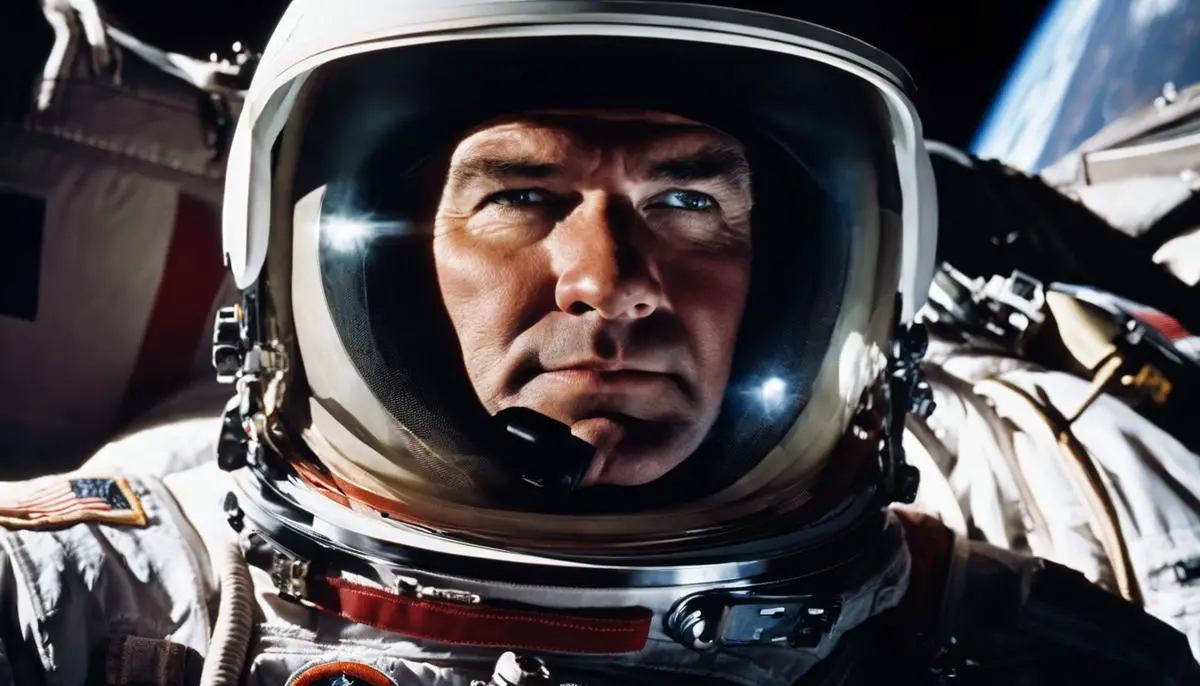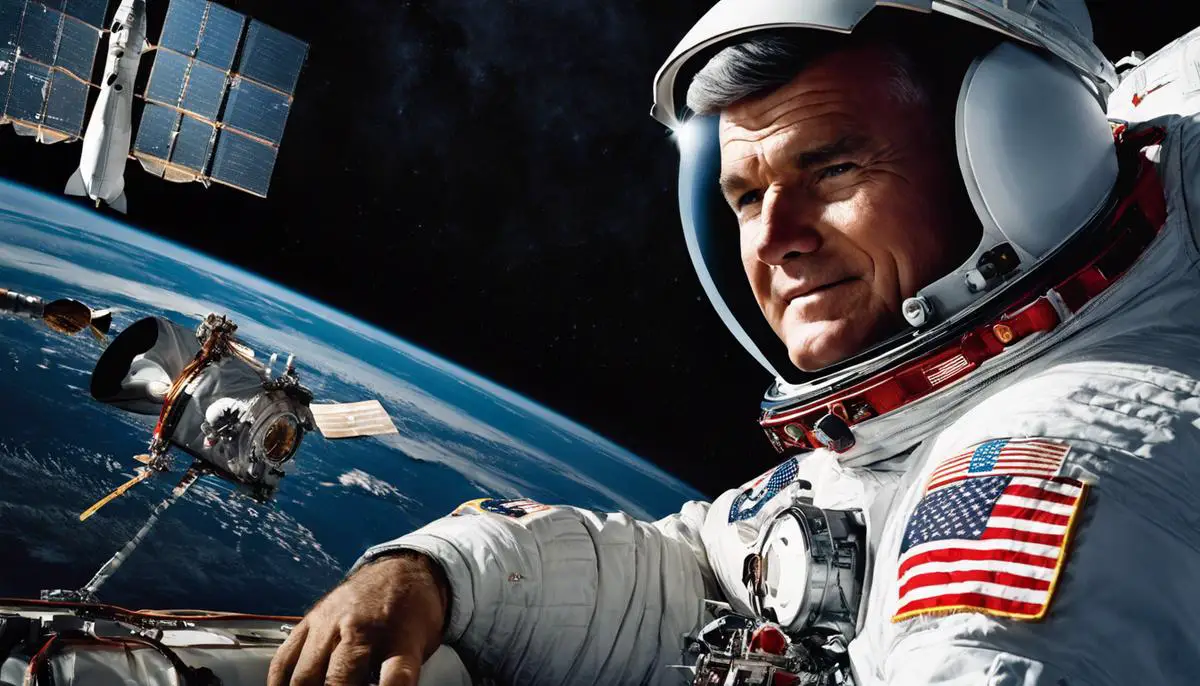Embarking on a journey through time and space, we venture into the life and legacy of an unsung hero of the Apollo era, astronaut Fred Haise. His remarkable odyssey from humble beginnings to the stellar heights of NASA’s Apollo 13 mission exemplifies the extraordinary tenacity and intellect required to reach for the stars. Haise’s biographical tapestry, woven with the threads of his education, early life influences, and the arduous journey to becoming an Apollo astronaut, unveils the portrait of an individual whose credentials and affiliations are as inspiring as the missions he embarked upon. We find, within this intricate narrative, not just the chronicle of a spacefarer, but a window into the very fabric of human endeavor, resilience, and the ceaseless pursuit of the unknown.
Contents
Fred Haise: Biographical Outline
In the annals of space exploration history, few names are as evocative of perseverance and technical expertise as Fred Haise, a pivotal figure within NASA’s Apollo program. Having dedicated the better part of his career to advancing the frontiers of aerospace science, Haise is a paragon of astronautic diligence and a living testament to the power of purpose-driven scientific inquiry. This discourse seeks to elucidate Haise’s trajectory from a nascent aviator to a venerated member of the Apollo astronaut corps.
Fred Haise was born on November 14, 1933, in Biloxi, Mississippi. His early life, marked by a keen interest in aviation, laid the groundwork for a distinguished career in both military service and aerospace explorations. Following an education imbued with the sciences, Haise enlisted in the United States Navy, where he rigorously trained to become a pilot. His tenure in naval aviation honed his skills, endowing him with the technical proficiency and aerodynamic acumen fundamental to his future undertakings.
Post his naval service, Haise continued to amplify his expertise as an aeronautical engineer, integrating his practical experience with an expanded knowledge base in flight dynamics and aerospace technologies. His work as a test pilot proved ineffably invaluable, not only in assessing the viability of novel aircraft designs but also in cultivating a mindset attuned to the meticulous analytics required for operating in the unforgiving bastion of space.
When NASA issued the clarion call for astronauts to spearhead its Apollo missions — a herald to humankind’s most audacious attempt to set foot upon the celestial bodies that wreathe our world — Haise was among the select cadre of individuals whose attributes aligned consummately with the arduous demands of spaceflight. His selection in 1966 as part of Astronaut Group 5 was predicated on an amalgamation of his pronounced piloting finesse, engineering insight, and unwavering commitment to the objectives delineated by the space program.
Haise’s most widely recognized contribution to aerospace science materialized with the ill-fated Apollo 13 mission, where he served as the lunar module pilot. The mission, intended to perform scientific exploration on the moon’s Fra Mauro highlands, became a harrowing tale of survival and ingenuity when an oxygen tank explosion compromised the spacecraft. Under extreme duress, Haise’s adept problem-solving capabilities, along with his and his crewmates’ level-headedness, catalyzed the formulation of solutions that ensured their safe return to Earth, thereby extolling the human spirit in the face of adversity.
The dedication with which Fred Haise approached his astronautical profession orchestrates an inspiring narrative for both academic and scientific communities. Haise’s legacy lies not only in the ventures he embarked upon but equally in the intrinsic motivation that propelled him through a career marked by the ceaseless quest for knowledge and the unyielding desire to push the boundaries of human capability. His life’s trajectory embodies the quintessence of scientific pursuit – an unwavering journey driven by passion, precision, and profound enthusiasm for exploration.

Apollo 13 Mission: A Detailed Analysis
The Apollo 13 mission, with Fred Haise aboard as the lunar module pilot, had objectives that were both ambitious and systematic. The primary goal was to continue the exploration of the Moon, following the successful footsteps of Apollo 11 and 12. Specifically, the mission aimed to land in the Fra Mauro highlands—a location that promised to offer significant geological insights, potentially revealing the Moon’s ancient past.
However, as meticulously planned as space expeditions are, they are not immune to the caprices of technology and the harsh environment of space. Amongst the substantial challenges that Apollo 13 encountered, the most notorious was the service module’s oxygen tank failure, which occurred approximately 56 hours into the mission. This critical malfunction precipitated a cascade of complications that compelled the crew to abort the lunar landing.
Henceforth, the mission’s imperatives rapidly shifted from exploration to survival. The primary challenge became to safely return the crew to Earth, utilizing the lunar module, Aquarius, as a lifeboat—a function for which it was not originally designed. This exigency tested the ingenuity and resilience of both the astronauts on board and the mission control team on Earth.
The adaptation of Aquarius’ systems to support the crew for the duration of the return trip presented multifaceted difficulties. Among these were the management of consumable resources such as water and power, the need to devise a new flight trajectory for safe re-entry into Earth’s atmosphere, and the regulation of cabin temperature and carbon dioxide levels.
Furthermore, there was the psychological challenge of maintaining morale and focus amidst acute stress and dwindling supplies. All three astronauts, united by their profound dedication to the mission and to each other’s survival, worked in concert with ground teams to surmount these adversities. They exhibited exceptional problem-solving skills and kept a level-headed approach throughout the unforeseen circumstances.
The Apollo 13 mission, while not meeting its original scientific objectives, served as a profound demonstration of human tenacity and adaptability. It underscored the unequivocal necessity of meticulous emergency preparedness and the potential for human innovation in space exploration. Even without fulfilling its intended exploration of the Fra Mauro highlands, the mission contributed valuable lessons to the annals of aeronautical engineering and mission critical decision-making, which continue to shape spaceflight safety protocols and contingency planning.
The successful return of Apollo 13’s crew, with Fred Haise playing a pivotal role in the face of daunting odds, stands as a testament to the relentless human spirit and the imperative of supporting continued research and advancement in space exploration. Through analysis and understanding of such challenging missions, the field honors the legacy of astronauts like Haise and ensures that their dedication continues to propel humanity’s reach well beyond the confines of our terrestrial horizon.

The Unforeseen Crisis and Ingenious Problem-Solving
The Apollo 13 mission, as is widely known, encountered a critical malfunction when an oxygen tank in the service module failed approximately 56 hours into flight. This catastrophic event necessitated an immediate cessation of the mission’s primary objective: landing on the Moon. Rather, the focus was redirected towards a singular, imperative goal—safeguarding the lives of the astronauts and ensuring their safe return to Earth.
As the mission unfolded into a precarious life-or-death scenario, the collective expertise and concerted efforts of both the crew and the support teams on the ground were of the utmost importance. The lunar module, Aquarius, though intended solely to land on the lunar surface, became an impromptu “lifeboat” for the astronauts. Its systems had to be repurposed and adapted to sustain life for the duration of the trip back home.
Addressing the management of consumable resources such as water, oxygen, and power required meticulous calculation and discipline. The available resources were finite and precariously low, thus rationing became critical. The crew had to face the additional burden of devising a new flight trajectory, one that could bring them back to Earth efficiently and safely using the gravitational pull of the Moon, as the damaged service module no longer functioned as intended.
Beyond the technical challenges, the psychological fortitude of the crew was put to the test. It was crucial to maintain morale amidst the uncertainty and stress of the crisis. The exceptional problem-solving skills and composure of the astronauts, in tandem with the support from mission control, showcased the resilience and adaptability of the human spirit.
The lessons learned from the hurdles encountered by the crew of Apollo 13 were profound. They contributed significantly to enhancing spaceflight safety protocols and contingency planning, underpinning the paramount importance of preparing for unforeseen errors. This incident served as a testimony to the indispensable role of indefatigable human ingenuity and the collective endeavor in the wake of unexpected challenges.
In a broader perspective, such tribulations accentuate the supporting role of research and advancement in the field of space exploration. They elucidate the necessity for continuous learning and the refinement of practices, ensuring that each mission advances the threshold of safety and knowledge in space travel.
The legacy and contributions of astronauts like Fred Haise extend beyond their own missions. They fortify humanity’s endeavor to expand our presence in space, while underscoring the intrinsic value of perseverance and the relentless quest for discovery. The chronicles of Apollo 13 not only illustrate the potential for catastrophe but also highlight the triumph of collaborative problem-solving in overcoming even the most daunting of odds.

Fred Haise’s Contribution to Space Exploration Post-Apollo 13
Following the harrowing experience of Apollo 13, Fred Haise remained a stalwart figure in the realm of space exploration, contributing significantly to subsequent NASA activities and the broader aerospace community.
Post-Apollo 13, Mr. Haise maintained his role at NASA as an astronaut, preparing for future potential lunar missions. When the Apollo program was curtailed, he shifted focus and became a critical component of the Space Shuttle program. In this capacity, he worked as the commander of five different Space Shuttle approach and landing test flights. These tests were vital in demonstrating the Orbiter’s capabilities for controlled descent and atmospheric flight.
In parallel with his hands-on work, he served as a key member of the backup crews for the Apollo 16 and 17 missions, ensuring operational continuity and broadening NASA’s reservoir of experienced astronauts acquainted with both successes and contingencies in human spaceflight.
Mr. Haise materially contributed to refining and expanding the training protocols for astronauts. Understanding the paramount importance of rigorous preparation, borne of his own experiences in space, his endeavors helped to solidify the safety and efficiency of astronaut training programs, undoubtedly saving lives and enhancing mission success rates.
Following his active service as an astronaut, Mr. Haise remained involved in the space community through leadership positions at Grumman Aerospace Corporation, where he focused on the development of advanced space vehicles and technologies. His insights into spacecraft design and operation informed future generations of aerospace vehicles and systems.
Additionally, Mr. Haise’s dedication extended into educational outreach. His passion for space exploration was communicated through his involvement with various groups and his engagement with students. By animating the next generation with a fascination for space, he played a pivotal role in ensuring the vibrancy of future exploratory endeavors.
Throughout all these pursuits, his involvement in space safety continued to be a primary focus. The lessons gleaned from the Apollo 13 mission underpinned his advocacy for meticulous safety measures, operational scrutiny, and contingency preparedness, all of which are now embedded in the culture of manned spaceflight.
One must recognize the enduring contributions of Fred Haise not merely in the days following his Apollo mission, but in the decades of service to the aerospace community that sustained the ever-forward momentum of human space exploration.

Fred Haise’s journey with NASA and the indelible mark he left on space exploration serve as both a historical account and a beacon for future generations. Beyond the harrowing experience of Apollo 13, his career continued to shape the trajectory of spaceflight and contribute to the groundwork of the shuttle era and beyond. As we reflect upon the chapters of his life—each depicting a relentless pursuit of scientific discovery, the triumphs over adversity, and the evolution of space policy and technology—we honor a legacy that transcends time and space, propelling humanity’s celestial aspirations on a path illuminated by the unyielding spirit of explorers like Haise.
